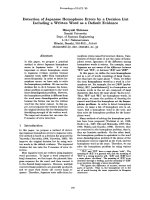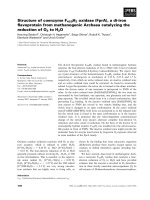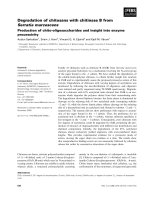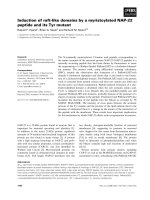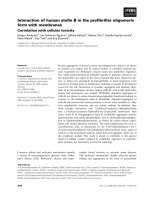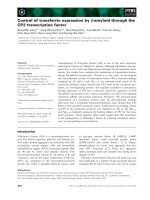Báo cáo khoa học: " Efficacy of consensus interferon in treatment of HbeAg-positive chronic hepatitis B: a multicentre, randomized controlled trial" docx
Bạn đang xem bản rút gọn của tài liệu. Xem và tải ngay bản đầy đủ của tài liệu tại đây (201.2 KB, 6 trang )
BioMed Central
Page 1 of 6
(page number not for citation purposes)
Virology Journal
Open Access
Research
Efficacy of consensus interferon in treatment of HbeAg-positive
chronic hepatitis B: a multicentre, randomized controlled trial
YongLi Zheng
1,5
, LianSan Zhao*
1
, TaiXiang Wu
2
, ShuHua Guo
3
,
YaGang Chen
4
and TaoYou Zhou
1
Address:
1
Infectious Disease Centre, West China Hospital, Sichuan University, No. 37, Guo Xue Xiang, Chengdu, Sichuan Province, PR China,
2
Department of Epidemiology, West China Hospital of Sichuan University, Chengdu, Sichuan Province, PR China,
3
Department of Infectious
Diseases, The Second Affiliated Hospital of ChongQing Medical University, ChongQing, PR China,
4
Center of Infectious Diseases, The First
Affiliated Hospital of Medical School of Zhejiang University, Zhejiang Province, PR China and
5
Department of Infectious Diseases, First People's
Hospital of Yibin, No. 65, Wen Xing Street, Yibin, Sichuan Province, PR China
Email: YongLi Zheng - ; LianSan Zhao* - ; TaiXiang Wu - ;
ShuHua Guo - ; YaGang Chen - ; TaoYou Zhou -
* Corresponding author
Abstract
Background: Consensus interferon (CIFN) is a newly developed type I interferon.
Aims: This multicentre, controlled trial was conducted to determine the efficacy of CIFN and to
compare it with alpha-1b-interferon (IFN-α1b) in the treatment of patients with hepatitis B e
antigen (HBeAg)-positive chronic hepatitis B.
Methods: 144 Patients were randomly assigned to receive 9 μg CIFN (CIFN group) or 50 μg INF-
α1b (IFN-alpha group) subcutaneously 3 times weekly for 24 weeks, followed by 24 weeks of
observation. Efficacy was assessed by normalization of serum alanine transaminase (ALT) levels and
the non-detectability of serum hepatitis B virus DNA or HBeAg at the end of treatment and 24
weeks after stopping treatment.
Results: There was no statistically significant difference in the serological, virological and
biochemical parameters between CIFN and IFN-α1b groups at the end of the therapy and follow-
up period (p > 0.05). Overall, at the end of treatment, 7.0% (5/71) and 35.2% (25/71) of patients in
the CIFN group showed a complete or partial response compared with 7.4% (5/68) and 33.8% (23/
68) of the IFN-alpha group (p = 0.10). At 24 weeks after stopping treatment, 6.9% (5/72) and 37.5%
(27/72) of patients in the CIFN group showed complete response or partial response compared
with 7.1% (5/70) and 34.3% (24/70) of the IFN-alpha group (p = 0.10).
Conclusion: These findings suggest that 9 μg CIFN is effective in the treatment of patients with
HBeAg-positive chronic hepatitis B. It can gradually induce ALT normalization and HBV DNA
clearance and HBeAg loss or HBeAg/HBeAb seroconversion.
Published: 9 July 2009
Virology Journal 2009, 6:99 doi:10.1186/1743-422X-6-99
Received: 30 May 2009
Accepted: 9 July 2009
This article is available from: />© 2009 Zheng et al; licensee BioMed Central Ltd.
This is an Open Access article distributed under the terms of the Creative Commons Attribution License ( />),
which permits unrestricted use, distribution, and reproduction in any medium, provided the original work is properly cited.
Virology Journal 2009, 6:99 />Page 2 of 6
(page number not for citation purposes)
Introduction
Hepatitis B, a serious liver disease caused by the hepatitis
B virus, can develop into cirrhosis of the liver or liver can-
cer[1]. Approximately 2 billion people have been infected
with hepatitis B virus and more than 350 million individ-
uals worldwide have chronic liver infections. Each year
1.4 million people die from HBV-related liver disease [2].
There is no specific treatment for chronic HBV infection.
Some drugs, including interferon and anti-viral agents [3],
can help a number of patients with chronic hepatitis B
infection [4]. Interferons were first described by Isaacs &
Lindenmann in 1957. Interferon-alpha has been used for
the treatment of chronic viral hepatitis for more than 20
years [5]. Many large clinical trials [6-8] and a meta-anal-
ysis [9] have proved that interferon is effective and safe in
the treatment of hepatitis B.
The effectiveness of interferon for patients with hepatitis B
has been widely recognized, but the effect is far from sat-
isfactory [10]. Interferon has the advantage of producing
a sustained virologic response after a defined, limited
course of treatment [11]. However, it has rather severe
side effects, and patients generally are not satisfied with
their response to interferon [12]. In-depth studies of inter-
feron have been conducted, and many new types of inter-
feron have been used in practice. Consensus interferon
(CIFN) is a new and non-natural type I interferon, which
is approved by the Federal Drug Administration for treat-
ment of chronic hepatitis C infection. It is a novel bioen-
gineered "consensus" molecule, composed of the most
frequently observed amino acid in each corresponding
position in the natural alpha interferons. CIFN shares an
89%, 30% and 60% homology with IFN alpha, IFN beta
and IFN omega, respectively [13]. In vitro studies have
shown that CIFN has a good affinity with the type-1 inter-
feron receptor, and its antiviral activity is 5 to 20 times
higher than traditional interferon [14]. Clinical studies
show that CIFN is effective for HCV infection [15,16]. Fur-
thermore, several large multi-centre studies showed that
patients with hepatitis C who do not respond to ordinary
IFN-alpha therapy may benefit from re-administration of
CIFN [17,18]. However, none of the the large clinical tri-
als currently underway with CIFN for chronic hepatitis B
have yet been reported.
On the basis of these observations, we conducted a mult-
icentre, randomized controlled trial to compare the effi-
cacy and safety of CIFN vs INF-λ1b therapy in patients
with chronic hepatitis B.
Patients and methods
Patients
A total of 144 Chinese patients were enrolled in the study.
All patients were outpatients from the West China Hospi-
tal of Sichuan University, the Second Affiliated Hospital
of Chongqing Medical University, and Zhejiang Medical
University Hospital. All patients signed informed consent
and the Ethics Committee approved the protocol and
minor changes in the program.
Inclusion criteria:(1) age 18 to 65 years; (2) presence of
HBsAg in serum for at least 6 months, and HBeAg-positive
at least once during the screening of PCR HBV-DNA ≥ 10
5
copies/ml; (3) in the 35 days before treatment, patients
must have had at least one occurrence of an ALT ≥ 2 times
the upper limit of normal (ULM, 40 IU/L), but the highest
ALT must have been ≤ 10 times ULM, and serum total
bilirubin must have been lower than the ULM. Exclusion
criteria included prior treatment for CHB with IFN-alpha
or another antiviral or immunosuppressive drug; presence
of antibodies to hepatitis A, C or D virus, or HIV; decom-
pensated liver disease (more than 7 points by Child-Pugh
evaluation or serum bilirubin > 2 times ULM, pro-
thrombin time prolongation > 6 seconds, low serum albu-
min level, or history of ascites, variceal hemorrhage or
hepatic encephalopathy); another cause of chronic liver
disease; evidence of hepatocellular cancer or other
tumors; history of alcoholism and drug abuse; history of
a serious disease of the heart, brain, lung, kidney, thyroid
or other important organ, the nervous system history, his-
tory of autoimmune disease or history of a blood disor-
der; allergy history; being pregnant, or breast-feeding if
female; organ transplant history; any contraindication to
the use of IFN-α; or lack of informed consent [19].
Methods
The study was a multicentre, randomized controlled trial
that followed a detailed protocol. Statisticians calculated
the number of samples in advance. Subject designer gen-
erated the allocation sequence according to a table of ran-
dom numbers before recruiting the participants; 3
allocation sequence copies were sealed in opaque enve-
lopes, which were kept confidential. The person who gen-
erated the allocation sequence did not recruit the
participants. Both participants and results were masked
during the treatment and follow-up [20]. Consecutive
patients who fulfilled the enrolment criteria were ran-
domly divided into 2 groups to receive either 9 μg CIFN
(CIFN group) or 50 μg INF-α1b (IFN-alpha group) subcu-
taneously 3 times weekly for 24 weeks, followed by 24
weeks of observation.
An analysis of efficacy was performed for all patients who
completed the appropriate experimental project in a spec-
ified time. Serum complete blood count and biochemical
profile, as well as hepatitis serology (HBsAg, anti-HBs,
HBeAg, anti-HBe and anti-HBc) was obtained at baseline
and then every 4 weeks until the end of treatment, and 8,
16, and 24 weeks after treatment. These tests were con-
Virology Journal 2009, 6:99 />Page 3 of 6
(page number not for citation purposes)
ducted in a common centre. HBV-DNA was measured
quantitatively by real-time polymerase chain reaction
(ULM, HBV DNA < 1,000 copies/mL). Hepatitis serology
was done using third-generation ELISA test kits (Equipar,
Saronno, Italy).
Virologic response was defined as HBeAg seroconversion,
loss of HBeAg and non-detectable HBV-DNA level, and
biochemical response as normalization of ALT level. The
virologic and biochemical responses between the two
groups were assessed at the end of treatment (at 24 weeks)
and at 24 weeks after the end of treatment (at 48 weeks).
Complete response was defined as HBeAg seroconversion,
clearance of HBV DNA and normalization of ALT. Partial
response was defined as normalization of ALT and no
HBV DNA clearance but a reduction in hepatitis B virus
deoxyribonucleic acid (HBV DNA) of ≥ log10 copies/mL
or no HBeAg seroconversion. No response was defined as
no ALT normalization, a decline of HBV-DNA less than 2
log10 copies/mL and no HBeAg seroconversion or no loss
of HbeAg [21].
Statistical Analyses
Statistical Package for the Social Sciences (version 16.0)
was used to conduct all statistical tests. Quantitative vari-
ables were expressed as mean and standard deviation.
Hepatitis B virus DNA was logarithmically transformed
for analysis. Quantitative and qualitative parameters were
compared using the Mann-Whitney U test and Pearson
chi squared tests or Fisher's exact test, respectively. A p
value less than 0.05 was considered statistically signifi-
cant. All statistical tests were 2-sided.
Results
One hundred forty-four patients were enrolled in the
study and all completed treatment. Female patients com-
prised 28 of 72 participants in the CIFN group and 23 of
72 participants in the IFN-alpha group. At baseline, the
level of HBV-DNA was 1.07*10
8
(mean) ± 2.90*10
8
(S.D.) in the CIFN group and 0.70*10
8
± 1.03*10
8
in the
IFN-alpha group. ALT level was 194.18 ± 84.00 in the
CIFN group and 191.61 ± 89.16 in the IFN-alpha group.
Patients between the 2 groups had similar baseline char-
acteristics with respect to age, gender, ALT and HBV DNA
levels and Case history (see Table 1). No patients with-
drew from the study because of side effects. However, 1
case in the CIFN group and 4 cases in the IFN-alpha group
had missing data at the end of treatment. All patients in
the CIFN group and 70 of 72 in the IFN-alpha group com-
pleted the follow-up.
At the end of treatment, ALT normalization was observed
in 38 of 71 (53.5%) patients in the CIFN group and 41 of
68 (60.3%) patients in the IFN-alpha group (p > 0.05).
Loss of HBV-DNA was found in 25.4% (18 of 71) of the
CIFN group patients and 20.6% (14 of 68) of the IFN-
alpha group patients. Rates of HBeAg/anti-HBe serocon-
version were 14.1% (10/71) in the CIFN group and 22.1%
(15/68) in the IFN-alpha group at the end of therapy (p >
0.05). Loss of HBeAg was evident in 14.1% (10/71) of the
CIFN group patients and 10.3% (7/68) of the IFN-alpha
group patients (see Table 2).
At 24 weeks after stopping treatment, ALT normalization
was observed in 38 of 72 (52.8%) patients in the CIFN
group and 37 of 70 (52.9%) patients in the IFN-alpha
group (p > 0.05). Loss of HBV-DNA was found in 23.6%
(17 of 72) of the CIFN group patients and 20.0% (14 of
70) of the IFN-alpha group patients. The rates of HBeAg/
anti-HBe seroconversion at the end of the follow-up
period were 16.7% (12/72) in the CIFN group and 17.1%
(12/70) in the IFN-alpha group (p > 0.05). Loss of HBeAg
was observed in 15.3% (11/72) of the CIFN group and
14.3% (10/70) of the IFN-alpha group (see Table 3).
Complete response was observed in 5 of 71 patients in the
CIFN group and 5 of 68 patients in the IFN-alpha group
(p > 0.05) at the end of treatment. During the follow-up
period, complete response was seen in 5 of 72 patients in
the CIFN group and 5 of 70 patients in the IFN-alpha
group. The rates of partial response between CIFN group
and IFN-alpha group were 35.2% (25/71) and 33.8% (23/
68) at the end of treatment. During the follow-up period,
partial response was observed in 37.5% (27/72) of the
CIFN group and 34.3% (24/70) of the IFN-alpha group.
At the end of the treatment and follow-up periods, none
of the patients had loss of HBsAg or appearance of anti-
HBs.
Table 1: Baseline Patient Characteristics
Characteristic CIFN group
(n = 72)
IFN-alpha group
(n = 72)
Age, years (mean ± S.D.) 24.8 ± 7.1 27.5 ± 5.4
Female, n (%) 28 (38.9) 23 (31.9)
Case history, years (mean ± S.D.) 6.3 ± 1.1 5.9 ± 1.3
ALT level (mean ± S.D.) 194.18 ± 84.00 191.61 ± 89.16
HBV DNA level (mean ± S.D.) 1.07*10
8
± 2.90*10
8
0.70*10
8
± 1.03*10
8
CIFN, consensus interferon; IFN, interferon; S.D., standard deviation
Virology Journal 2009, 6:99 />Page 4 of 6
(page number not for citation purposes)
Discussion
There is no specific treatment for hepatitis B, a serious and
widely epidemic disease. Interferon has a double mecha-
nism of anti-viral properties and immune regulation for
viral hepatitis, therefore, it is widely used in the treatment
of hepatitis B virus [22]. CIFN has a certain advantage for
hepatitis C infection, yet its efficacy in the treatment of
patients with hepatitis B has not been clear. This multicen-
tre, randomized, controlled trial was conducted in Chi-
nese patients positive for HBeAg chronic hepatitis B to
determine the efficacy of CIFN in these patients.
The results revealed that CIFN is as effective as INF-α1b
for HBeAg-positive chronic hepatitis B. No statistically sig-
nificant difference existed in the serological, virological
and biochemical parameters between the CIFN and IFN-
α1b groups at the end of therapy or the follow-up period.
The rates of complete or partial response between the
CIFN group and the IFN-alpha group were 42.3% (30/71)
and 41.2% (28/68) at the end of treatment, and 44.4%
(32/72) and 41.4% (29/70) during the follow-up period,
respectively (p > 0.05). A decrease in HBV-DNA was found
in 42.3% of patients in the CIFN group compared with
41.2% of patients in the IFN-alpha group at the end of
treatment. At the end of follow-up, 44.4% of patients in
the CIFN group showed a decrease of HBV-DNA com-
pared with 34.3% of the IFN-alpha group (p > 0.05).
At the end of treatment, loss of HBeAg or HBeAg serocon-
version was observed in 32.4% of patients in the IFN-
alpha group and 28.2% of patients in the CIFN group. At
24 weeks after stopping treatment, 32.0% patients in the
CIFN group had a loss of HBeAg or HBeAg seroconversion
in comparison with 31.4% patients in the IFN-alpha
group.
Interferon is an important drug against the hepatitis B
virus and its efficacy has been widely accepted. Many
authors have had similar results with interferon as in our
trial [23,24]. The rate of sustained virologic response in
our study was between 20% and 50%. Many patients with
hepatitis B have benefited from interferon treatment.
Moreover, it has obvious advantages to HbeAg serocon-
version [25,26]. Our study also confirms that it is effective
for chronic hepatitis B virus infection.
Based on the aforementioned data, the dosage of alpha-1b
interferon was about 5.6 times higher than CIFN. How-
ever, it is difficult to distinguish the difference in efficacy
between the two agents. It was also confirmed by statisti-
cal analysis. On the one hand, the antiviral activity of the
same dosage of CIFN was stronger than that of alpha-1b
interferon; on the other hand, the necessary dose of CIFN
was lower. Therefore, we assessed the safety of 15 μg CIFN
for chronic hepatitis B in another trial. Preliminary results
indicate that this dose of CIFN was safe and the efficacy of
the high dose was superior to that of the low dose.
According to the literature, CIFN has been used for hepa-
titis C. Treatment of chronic hepatitis C infection with
CIFN in relapsers and non-responders to interferon-based
Table 2: Virologic, Biochemical Variables of Patients at 24 Weeks' Treatment
Variable CIFN group (n = 71) IFN-alpha group (n = 68)
ALT normalization, n (%) 38 (53.5) 41 (60.3)
Loss of HBV-DNA, n (%) 18 (25.4) 14 (20.6)
HBeAg/anti-HBe seroconversion, n (%) 10 (14.1) 15 (22.1)
Loss of HbeAg, n (%) 10 (14.1) 7 (10.3)
Complete response, n (%) 5 (7.0) 5 (7.4)
Partial response, n (%) 25 (35.2) 23 (33.8)
CIFN, consensus interferon; IFN, interferon
Table 3: Virologic, Biochemical Variables of Patients at 24 weeks After Treatment
Variable CIFN group
(n = 72)
IFN-alpha group
(n = 70)
ALT normalization, n (%) 38 (52.8) 37 (52.9)
Loss of HBV-DNA, n (%) 17 (23.6) 14 (20.0)
HBeAg/anti-HBe seroconversion, n (%) 12 (16.7) 12 (17.1)
Loss of HbeAg, n (%) 11 (15.3) 10 (14.3)
Complete response, n (%) 5 (6.9) 5 (7.1)
Partial response, n (%) 27 (37.5) 24 (34.3)
CIFN, consensus interferon; IFN, interferon
Virology Journal 2009, 6:99 />Page 5 of 6
(page number not for citation purposes)
therapy has achieved a certain efficacy [27-29]. Our study
suggests that CIFN is effective in retreating patients with
chronic hepatitis B infection who failed therapy with
interferon alpha.
CIFN has been used for patients with not only hepatitis C
but also hepatitis B. The disease burden of hepatitis B is
more serious in Asian countries, particularly in China.
Therefore, CIFN could be an alternative drug for hepatitis
B infection in these areas.
In conclusion, the results of this trial demonstrate that a
24-week course of CIFN therapy is effective for patients
with HBeAg-positive chronic hepatitis B. Furthermore, it
gradually induces sustained ALT normalization and HBV-
DNA clearance and HBeAg loss or HBeAg/HBeAb sero-
conversion. The therapy was well tolerated by all volun-
teers who completed the treatment and follow-up
periods. We will report its safety in another article in
detail. We have observed the best indication and individ-
ual characteristics of CIFN. Further study of efficacy and
safety will be performed after administration to patients
in a large-scale trial, and advantages and disadvantages of
CIFN will be compared with existing interferon.
Competing interests
The authors declare that they have no competing interests.
Authors' contributions
ZLS, ZYL and WTX were responsible for planning the
study, analyzing the results and drafting the manuscript.
ZYL wrote the manuscript. GSH, CYG, ZTY and ZYL col-
lected the study material and coordinated the study. All
authors have read and approved the manuscript.
Acknowledgements
The authors acknowledge the cooperation of the staff of the Infectious Dis-
eases Centre and Laboratory Centre of West China Hospital of Sichuan
University, the Department of Infectious Diseases of Second Affiliated Hos-
pital of ChongQing Medical University and Centre of Infectious Diseases of
First Affiliated Hospital of Medical School of Zhejiang University for partic-
ipating in the research project. The authors are indebted to the staff of the
Epidemiology of West China Hospital of Sichuan University for their critical
analysis of the study data, and we especially thank Professor BinJun Lei for
providing excellent advice and technical assistance.
References
1. Quan DJ: Pharmacotherapy of hepatitis B infection: a brief
review. Nephrol Nurs J 2008, 35(5):507-10.
2. World Health Organisation: Hepatitis B. Fact sheet 204 2008 [http:/
/www.who.int/mediacentre/factsheets/fs204/en/]. Accessed 18
November 2008
3. Planas R, Morillas RM: Treatment of hepatitis B virus infection:
present and future. Gastroenterol Hepatol. 2008, 31(6):349-355.
4. Keeffe EB, Dieterich DT, Han SH, Jacobson IM, Martin P, Schiff ER,
Tobias H: A treatment algorithm for the management of
chronic hepatitis B virus infection in the United States: 2008
Update. Clin Gastroenterol Hepatol 2008, 6(12):1315-41.
5. Ramos-Bello D, Ramos-Niembro F: A review of interferons: fifty
years later (1957–2007). Gac Med Mex 2008, 144(1):55-65.
6. Truong BX, Seo Y, Kato M, Hamano K, Ninomiya T, Katayama M,
Kato H, Yano Y, Hayashi Y, Kasuga M: Long-term follow-up of
Japanese patients with chronic hepatitis B treated with inter-
feron-alpha. Int J Mol Med 2005, 16(2):279-84.
7. Lin SM, Tai DI, Chien RN, Sheen IS, Chu CM, Liaw YF: Comparison
of long-term effects of lymphoblastoid interferon alpha and
recombinant interferon alpha-2a therapy in patients with
chronic hepatitis B. J Viral Hepat 2004, 11(4):349-57.
8. Hsu HY, Tsai HY, Wu TC, Chiang CL, Ni YH, Chen PJ, Chang MH:
Interferon-alpha treatment in children and young adults
with chronic hepatitis B: a long-term follow-up study in Tai-
wan. Liver Int 2008, 28(9):1288-97.
9. Sung JJ, Tsoi KK, Wong VW, Li KC, Chan HL, et al.: Meta-analysis:
Treatment of hepatitis B infection reduces risk of hepato-
cellular carcinoma. Aliment Pharmacol Ther 2008, 28(9):1067-77.
10. Asselah T, Lada O, Boyer N, Martinot M, Marcellin P: Treatment of
chronic hepatitis. Brit J Gastroenterol Clin Biol 2008, 32(8–
9):749-68.
11. Fung J, Lai CL, Yuen MF: New paradigms for the treatment of
chronic hepatitis. J Gastroenterol Hepatol. 2008, 23(8 Pt
1):1182-1192.
12. Inada M, Yokosuka O: Current antiviral therapies for chronic
hepatitis B. Hepatol Res
2008, 38(6):535-42.
13. Melian EB, Plosker GL: Interferon alfacon-1: a review of its phar-
macology and therapeutic efficacy in the treatment of
chronic hepatitis C. Drugs 2001, 61(11):1661-91.
14. Hutson TE, Molto L, Mekhail T, Elson P, Finke J, Tannenbaum C, Bor-
den E, Dreicer R, Olencki T, Bukowski RM: Phase I trial of consen-
sus interferon in patients with metastatic renal cell
carcinoma: toxicity and immunological effects. Clin Cancer Res
2003, 9(4):1354-60.
15. Miglioresi L, Bacosi M, Russo F, Patrizi F, Saccenti P, Ursitti A, Angelis
AD, Ricci GL: Consensus interferon versus interferon-alpha 2b
plus ribavirin in patients with relapsing HCV infection. Hepa-
tol Res 2003, 27(4):253-9.
16. Fattovich G, Zagni I, Minola E, Felder M, Rovere P, Carlotto A, Sup-
pressa S, Miracolo A, Paternoster C, Rizzo C, Rossini A, Benedetti P,
Capanni M, Ferrara C, Costa P, Bertin T, Pantalena M, Lomonaco L,
Scattolini C, Mazzella G, Giusti M, Boccia S, Milani S, Marin R, Lisa Rib-
ero M, Tagger A: A randomized trial of consensus interferon in
combination with ribavirin as initial treatment for chronic
hepatitis C. J Hepatol 2003, 39(5):843-9.
17. Steffen M, Cornberg M, Buggisch P: Treatment of chronic hepati-
tis C with consensus interferon in relapsers and non-
responders to interferon-based therapy. Hepatogastroenterology
2007, 54(80):2368-72.
18. Kemmer N, Neff GW: Managing chronic hepatitis C in the dif-
ficult-to-treat patient. Liver Int 2007, 27(10):1297-310.
19. Flisiak R, Jaroszewicz J: Treatment recommendations of
chronic hepatitis B. Did the world escape us? Przegl Epidemiol
2008, 62(1):133-8.
20. Wood L, Egger M, Gluud LL, Schulz KF, Jüni P, Altman DG, Gluud C,
Martin RM, Wood AJ, Sterne JA: Empirical evidence of bias in
treatment effect estimates in controlled trials with different
interventions and outcomes: meta-epidemiological study. Br
Med J 2008, 336(7644):601-5.
21. Pawlotsky JM, Dusheik OG, Hatzakis A, Lau D, Lau G, Liang TJ,
Locarnini S, Martin P, Richman DD, Zoulim F: Virologic monitor-
ing of hepatitis B virus therapy in clinical trials and practice:
recommendations for a standardized approach.
Gastroenterol-
ogy 2008, 134(2):405-15.
22. Pedersen C, Pedersen CR: Treatment of chronic viral hepatitis.
Ugeskr Laeger 2008, 170(24):2137-40.
23. Kumada H: Advance in technical method and treatment for
viral hepatitis. Rinsho Byori 2008, 56(2):108-13.
24. Colle I, Adler M, Brenard R, Henrion J, Langlet P, Michielsen P, Orlent
H, Reynaert H, Sprengers D, Stärkel P, Van Damme P, Verslype C,
Delwaide J, Belgian Association for the Study of the Liver: Manage-
ment and treatment of chronic hepatitis B virus: Belgian
Association for the Study of the Liver (BASL) 2007 guide-
lines. Acta Gastroenterol Belg 2007, 70(4):389-420.
25. Balsano C, Alisi A: Viral hepatitis B: established and emerging
therapies. Curr Med Chem 2008, 15(9):930-9.
26. Zoulim F, Perrillo R: Hepatitis B: reflections on the current
approach to antiviral therapy. J Hepatol 2008, 48(Suppl
1):S2-19.
Publish with BioMed Central and every
scientist can read your work free of charge
"BioMed Central will be the most significant development for
disseminating the results of biomedical research in our lifetime."
Sir Paul Nurse, Cancer Research UK
Your research papers will be:
available free of charge to the entire biomedical community
peer reviewed and published immediately upon acceptance
cited in PubMed and archived on PubMed Central
yours — you keep the copyright
Submit your manuscript here:
/>BioMedcentral
Virology Journal 2009, 6:99 />Page 6 of 6
(page number not for citation purposes)
27. Montalbano M, Kemmer N, Neff GW: Managing chronic hepatitis
C in relapsers and non-responders. Minerva Gastroenterol Dietol
2008, 54(1):31-47.
28. Cornberg M, Hadem J, Herrmann E, Schuppert F, Schmidt HH, Reiser
M, Marschal O, Steffen M, Manns MP, Wedemeyer H: Treatment
with daily consensus interferon (CIFN) plus ribavirin in non-
responder patients with chronic hepatitis C: a randomized
open-label pilot study. Turk J Gastroenterol 2006, 17(1):35-9.
29. Böcher WO, Schuchmann M, Link R, Hillenbrand H, Rahman F,
Sprinzl M, Mudter J, Löhr HF, Galle PR: Consensus interferon and
ribavirin for patients with chronic hepatitis C and failure of
previous interferon-alpha therapy. Liver Int 2006, 26(3):319-25.

